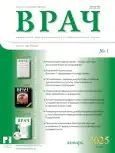Optimization of diagnostics of urogenital tract infections caused by obligate pathogens in women
- Authors: Lipova E.V.1, Vitvitskaya Y.G.1, Glazko I.I.1, Karasev E.A.1, Volgin V.N.1
-
Affiliations:
- State Research Center – A.I. Burnazyan Federal Medical Biophysical Center of the Federal Medical and Biological Agency of Russia
- Issue: Vol 36, No 1 (2025)
- Pages: 25-29
- Section: For Diagnosis
- URL: https://journals.eco-vector.com/0236-3054/article/view/676820
- DOI: https://doi.org/10.29296/25877305-2025-01-05
- ID: 676820
Cite item
Abstract
Sexually transmitted infections remain an important medical and social problem. Untimely detection and, accordingly, late initiation of treatment lead to chronicity of the infectious-inflammatory process and the development of complications such as infertility.
Purpose. Assess the validity of diagnosing an infectious-inflammatory process based on the results of a microscopic examination - leukocyte reaction.
Material and methods. A retrospective analysis of medical records of 102 women was carried out, the results of microscopic examination, polymerase chain reaction (PCR), and real-time PCR were analyzed.
Results. The clinical picture in patients with obligate pathogens and patients with an inflammatory process caused by opportunistic microorganisms did not differ significantly: slightly and moderately severe clinical symptoms predominated. The infectious-inflammatory process caused by obligate pathogens was accompanied by an increase in the number of polymorphonuclear leukocytes only in 22.73% of cases; in other cases, the pathological process proceeded without a leukocyte reaction.
Conclusion. When diagnosing an infectious-inflammatory process, it is necessary to use not only routine methods, but also screening studies aimed at excluding obligate pathogens.
Full Text
About the authors
E. V. Lipova
State Research Center – A.I. Burnazyan Federal Medical Biophysical Center of the Federal Medical and Biological Agency of Russia
Author for correspondence.
Email: kursld@mail.ru
Professor, MD
Russian Federation, MoscowYu. G. Vitvitskaya
State Research Center – A.I. Burnazyan Federal Medical Biophysical Center of the Federal Medical and Biological Agency of Russia
Email: kursld@mail.ru
Candidate of Medical Sciences
Russian Federation, MoscowI. I. Glazko
State Research Center – A.I. Burnazyan Federal Medical Biophysical Center of the Federal Medical and Biological Agency of Russia
Email: kursld@mail.ru
Candidate of Medical Sciences; Associate Professor
Russian Federation, MoscowE. A. Karasev
State Research Center – A.I. Burnazyan Federal Medical Biophysical Center of the Federal Medical and Biological Agency of Russia
Email: kursld@mail.ru
Candidate of Medical Sciences
Russian Federation, MoscowV. N. Volgin
State Research Center – A.I. Burnazyan Federal Medical Biophysical Center of the Federal Medical and Biological Agency of Russia
Email: kursld@mail.ru
MD
Russian Federation, MoscowReferences
- WHO Global health sector strategy on Sexually Transmitted Infections, 2016–2021.
- Иванова М.А., Романова О.В. Заболеваемость инфекциями, передаваемыми половым путем, в Российской Федерации за период с 2006 по 2015 гг. Современные проблемы здравоохранения и медицинской статистики. 2016; 1: 8–12 [Ivanova M.A., Romanova O.V. Incidence of infections, sexually transmitted, in the Russian Federation from 2006 for 2015. Current problems of health care and medical statistics. 2016; 1: 8–12 (in Russ.)].
- Weinstock H., Berman S., Cates W. Jr. Sexually transmitted diseases among American youth: incidence and prevalence estimates. Perspect Sex Reprod Health. 2004; 36 (1): 6–10. doi: 10.1363/psrh.36.6.04
- Stamm W.E. Chlamydia screening: expanding the scope. Ann Intern Med. 2004; 141 (7): 570–2. doi: 10.7326/0003-4819-141-7-200410050-00016
- Mardh P.A. Tubal factor infertility, with special regard to chlamydial salpingitis. Curr Opin Infect Dis. 2004; 17 (1): 49–52. doi: 10.1097/00001432-200402000-00010
- Rahman M.U., Cheema M.A., Schumacher H.R. et al. Molecular evidence for the presence of Chlamydia in the synovium of patients with Reiter's syndrome. Arthritis Rheum. 1992; 35 (5): 521–9. doi: 10.1002/art.1780350506
- Rahman M.U., Hudson A.P., Schumacher H.R. Jr. Chlamydia and Reiter's syndrome (reactive arthritis). Rheum Dis Clin N Am. 1992; 18: 67–79.
- Sherrard J., Wilson J., Donders G. et al. 2018 European (IUSTI/WHO) International Union against sexually transmitted infections (IUSTI) World Health Organization (WHO) guideline on the management of vaginal discharge. Int J STD AIDS. 2018; 29 (13): 1258–72. doi: 10.1177/0956462418785451
- CDC 2021. URL: https://www.cdc.gov/std/treatment-guidelines/default.htm
- Hillier S.L., Krohn M.A., Klebanoff S.J. et al. The relationship of hydrogen peroxide-producing lactobacilli to bacterial vaginosis and genital microflora in pregnant women. Obstet Gynecol. 1992; 79 (3): 369–73. doi: 10.1097/00006250-199203000-00008
- Sewankambo N., Gray R.H., Wawer M.J. et al. HIV-1 infection associated with abnormal vaginal flora morphology and bacterial vaginosis. Lancet. 1997; 350 (9077): 546–50. doi: 10.1016/s0140-6736(97)01063-5
- Sobel J.D. Is there a protective role for vaginal flora? Curr Infect Dis Rep. 1999; 1 (4): 379–83. doi: 10.1007/s11908-999-0045-z
- Wiesenfeld H.C., Hillier S.L., Krohn M.A. et al. Bacterial vaginosis is a strong predictor of Neisseria gonorrhoeae and Chlamydia trachomatis infection. Clin Infect Dis. 2003; 36 (5): 663–8. doi: 10.1086/367658
- Brotman R.M., Klebanoff M.A., Nansel T.R. Bacterial vaginosis assessed by gram stain and diminished colonization resistance to incident gonococcal, chlamydial, and trichomonal genital infection. J Infect Dis. 2010; 202 (12): 1907–15. doi: 10.1086/657320
- van Houdt R., Ma B., Bruisten S.M., et al. Lactobacillus iners-dominated vaginal microbiota is associated with increased susceptibility to Chlamydia trachomatis infection in Dutch women: a case-control study. Sex Transm Infect. 2018; 94 (2): 117–23. doi: 10.1136/sextrans-2017-053133
- Hayes R., Watson-Jones D., Celum C. et al. Treatment of sexually transmitted infections for HIV prevention: end of the road or new beginning? AIDS. 2010; 24 (Suppl 4): S15–26. doi: 10.1097/01.aids.0000390704.35642.47
- Gosmann C., Anahtar M.N., Handley S.A. Lactobacillus-deficient cervicovaginal bacterial communities are associated with increased HIV acquisition in young South African women. Immunity. 2017; 46 (1): 29–37. doi: 10.1016/j.immuni.2016.12.013
- Cohen C.R., Lingappa J.R., Baeten J.M. et al. Bacterial vaginosis associated with increased risk of female-to-male HIV-1 transmission: a prospective cohort analysis among African couples. PLoS Med. 2012; 9 (6): e1001251. doi: 10.1371/journal.pmed.1001251
Supplementary files









